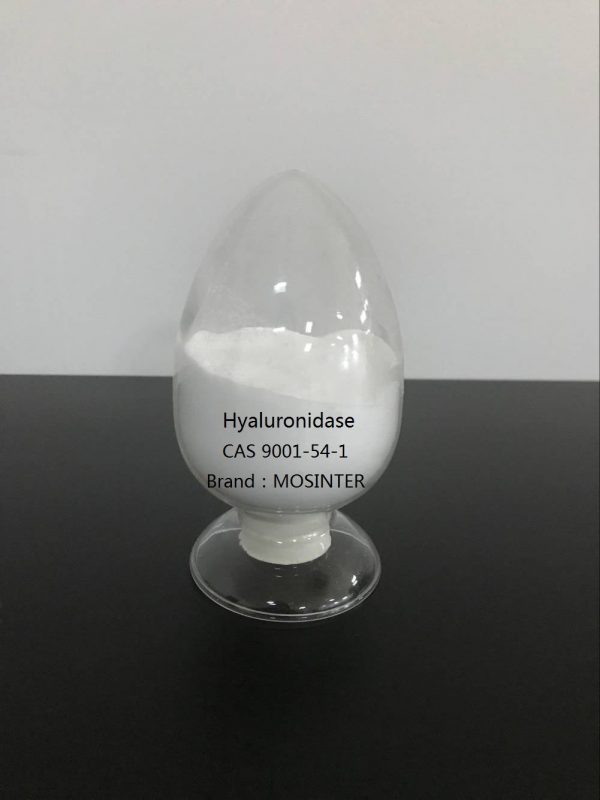- Have any questions?
- +86-189 8930 5995
- sales@mosinterchem.com.cn
Hyaluronidase CAS 9001-54-1

Cloquintocet-mexyl CAS 99607-70-2
11/12/2018
3-Indolebutyric acid CAS 133-32-4
11/12/2018| Model: | MOS9001-54-1 |
| Brand: | MOSINTER |
| cas: | 9001-54-1 |
| Appearance: | white to slightly brown |
| Storage condition: | -20°C |
| Content: | ≥98% |
| Alias: | Hyaluronidase(fromtestes) |
Hyaluronidase from streptomyces hyaluro-lyticus (CAS: 9001-54-1)
| Item | Index |
| Specification | CP/USP/EP |
| Appearance | white to slightly brown lyophilized powder |
| Storage Condition | −20°C |
Use as a drug
Brand names of animal-derived hyaluronidase include HydaseTM (developed and manufactured by PrimaPharm Inc., distributed by Akorn Inc.), which has been FDA-approved as a “thimerosal-free” animal-derived hyaluronidase, Vitrase (ISTA Pharmaceuticals), Amphadase (Amphastar Pharmaceuticals), and Wydase. Wydase, however, is no longer manufactured.By catalyzing the hydrolysis of hyaluronan, a constituent of the extracellular matrix (ECM), hyaluronidase lowers the viscosity of hyaluronan, thereby increasing tissue permeability. It is, therefore, used in medicine in conjunction with other medicine to speed their dispersion and delivery. Common applications are ophthalmic surgery, in combination with local anesthetics. It also increases the absorption rate of parenteral fluids given byhypodermoclysis, and is an adjunct in subcutaneous urography for improving resorption of radiopaque agents. Hyaluronidase is also used for extravasation of hyperosmolar solutions.
On December 2, 2005, the FDA approved a synthetic (recombinant or rDNA) “human” hyaluronidase, Hylenex (Halozyme Therapeutics).
Role in cancer
The role of hyaluronidases in cancer is controversial. Limited data support a role of lysosomal hyaluronidases in metastasis, while other data support a role in tumor suppression. Other studies suggest no contribution or effects independent of enzyme activity. Non-specific inhibitors (apigenin, sulfated glycosaminoglycans) or crude enzyme extracts have been used to test most hypotheses, making data difficult to interpret. It has been hypothesized that, by helping degrade the ECM surrounding the tumor, hyaluronidases help cancer cells escape from primary tumor masses. However, studies show that removal of hyaluronan from tumors prevents tumor invasion. Hyaluronidases are also thought to play a role in the process of angiogenesis, although most hyaluronidase preparations are contaminated with large amounts of angiogeneic growth factors. As previously mentioned, there are six hyaluronidase genes in the human genome, three of which can express active hyaluronidases (HYAL1, HYAL2 and PH20).
Role in pathogenesis
Some bacteria, such as Staphylococcus aureus, Streptococcus pyogenes, and Clostridium perfringens, produce hyaluronidase as a means of using hyaluronan as a carbon source. It is often speculated that Streptococcus and Staphylococcus pathogens use hyaluronidase as a virulence factor to destroy the polysaccharide that holds animal cells together, making it easier for the pathogen to spread through the tissues of the host organism, but no valid experimental data are available to support this hypothesis.
Role in fertilization
In most mammalian fertilization, hyaluronidase is released by the acrosome of the sperm cell after it has reached the oocyte, by digesting hyaluronan in the corona radiata, thus enabling conception. Gene-targeting studies show that hyaluronidases such as PH20 are not essential for fertilization, although exogenous hyaluronidases can disrupt the cumulus matrix.
The majority of mammalian ova are covered in a layer of granulosa cells intertwined in an ECM that contains a high concentration of hyaluronan. When a capacitated sperm reaches the ovum, it is able to penetrate this layer with the assistance of hyaluronidase enzymes present on the surface of the sperm. Once this occurs, the sperm is capable of binding with the zona pellucida, and the acrosome reaction can occur.
You must be logged in to post a review.


Reviews
There are no reviews yet.